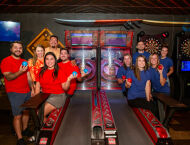Culture
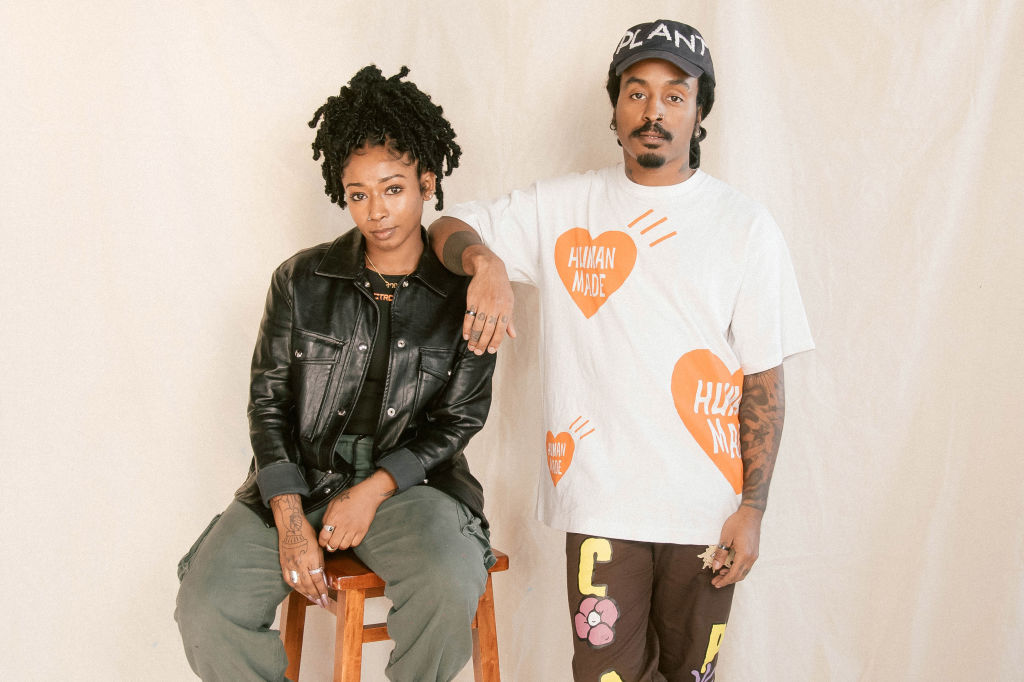 Trap Bob + Chris Pyrate. Photo by Dusty.
Trap Bob + Chris Pyrate. Photo by Dusty.
Cultivating The Scene: Trap Bob + Chris Pyrate on Building The Blueprint for D.C.’s Creative Renaissance
December 2, 2021 @ 12:00pm
“We’ve been waiting to have this conversation.”
Tenbeete Solomon, perhaps most recognized under her moniker Trap Bob, stands opposite Chris Pyrate in a sunlit artist studio at 52 O Street on a warm November afternoon as she speaks with intention.
“We spend hours talking about the same thing, and there’s always more to talk about.”
The recurring topic of fervent discussion for this pair of collaborators, peers, friends and most importantly, confidantes is navigating what it means to be artists in D.C. Our city is in the midst of a creative renaissance that’s only gaining momentum, and Solomon and Pyrate feel a strong sense of responsibility to create opportunities for open dialogue — not only with one another, but among all artists in the District.
“This is the Wild Wild West,” Pyrate says. “There’s no blueprint for how you should do this.”
We’re congregating in Jarell Mique’s bohemian studio space in Truxton Circle with photographer Omatseye Ajagbawa, known to most as Dusty, and artist Pierre Edwards of Studio Sonic. There’s something about the exposed wood beneath our feet, floor-to-ceiling windows, mismatched furniture with a smattering of quirky décor, and expansive canvas backdrop held up by clothes pins that lends itself perfectly to this conversation. It has the energy of a place where creating happens, and for three hours, we do just that.
What we’re creating isn’t a work of art, though. It’s an exchange of ideologies across different mediums about this moment we’re sharing as artists, curators and creative conduits in the District. And for some of us, it’s just old friends catching up.
Listening to Edwards shoot the shit with Pyrate and Solomon feels like walking into your ride or die’s house, plopping down on the couch, kicking your feet up and unloading about your day. They’ve circled each other’s orbits socially and artistically for years, and they’re proud of the District’s creative heartbeat. The way they see it, the city’s still very underground. D.C. keeps it authentic.
“The people who are known here are actually doing work [and] trying to push it forward, not just trying to be famous by themselves, whereas other cities are oversaturated,” Solomon says. “Why would I want to go and be another artist in L.A.?”
They’re in one accord. While expanding their artistic footprint in other cities is crucial to the success of their careers, D.C. remains home. They say a lot of artists don’t understand they can get the same exact outcome they’re gunning for in bigger cities by staying right in the nation’s capital. And unlike many, they’re not annoyed at how tightknit and sometimes bordering on incestuous our creative community can be.
“We all know each other,” Edward says.
“That’s already out of the way,” Solomon agrees. “And then you just do the work.”
Pyrate adds, “I feel like people focus on the negative aspect of the fact that we all know each other, but there’s a big positive to that.”
They see a collective respect among local artists who came from the same, or similar, beginnings. Creatives don’t usually come to our city “to come up.” They build their careers here, and often, their roots remain intact. We’re more of a home to creators than climbers, more of an incubator for purpose than accolades. We’re proud of the interconnectedness within our intimate grouping at 52 O Street, the sheer amount of overlap in our professional lives that allows us to speak candidly for an afternoon about the creative hub we see the District becoming and the support network we’ve built here.
“All we have is the conversations we have,” Solomon says. “We just try to share that as much as we can because we realize artists don’t [always] feel like they can voice how they feel or what they’re going through. It’s healthy to have those conversations with the people you work with.”
Only in D.C. are we exploring this uncharted territory together, cultivating a landscape for the future generation of creators. Only in D.C. can two established artists form such an indestructible bond that transcends their individual pursuits and permeates the creative scene. And only in D.C. can the five of us speak without a hidden agenda, without preconceived notions, and without any motivation other than carefully building a platform for who comes next and striving to get more eyes on our city.
The PBR Connection
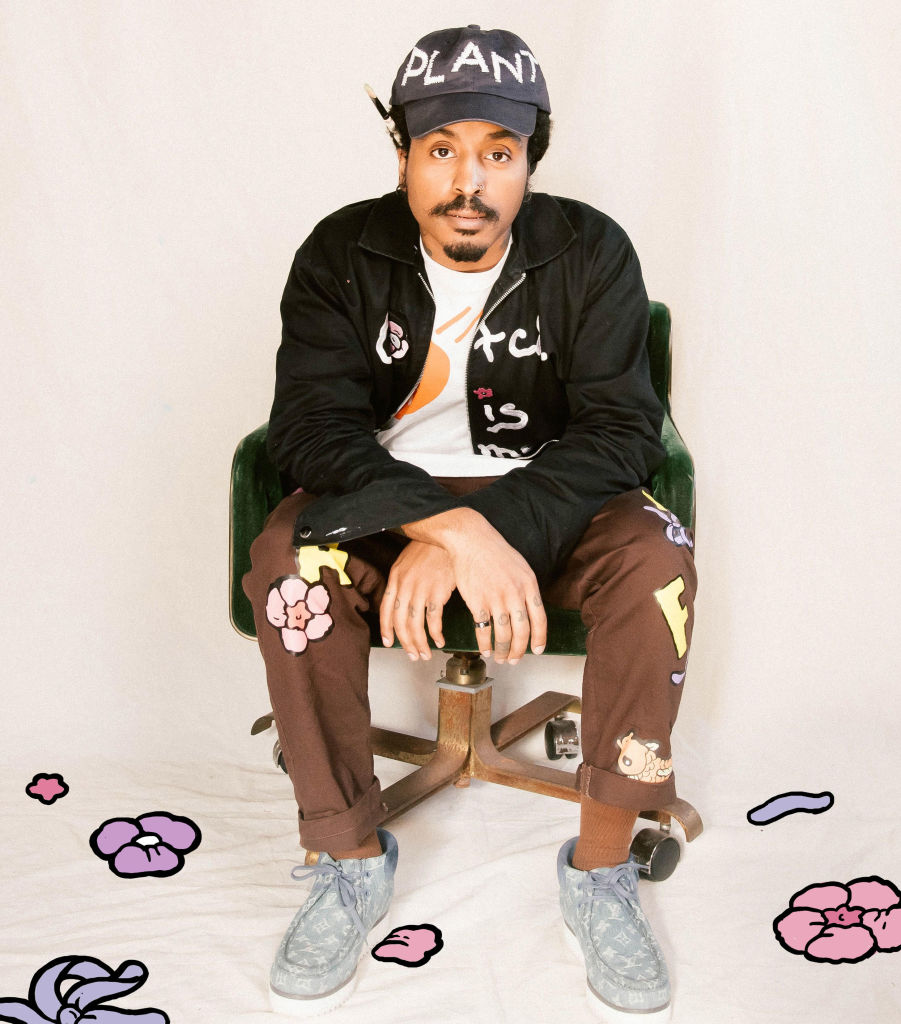
Chris Pyrate. Photo by Dusty + illustrations by Pyrate.
Solomon and Pyrate have only known each other for three years, but to hear them speak, you’d guess their friendship goes back decades. Solomon is about six years into her multidisciplinary career creating animations, illustrations, murals, paintings and whatever else she can get her hands on. And while Pyrate’s years as a professional muralist and designer is nearly double Solomon’s, they speak as peers who are constantly learning from one another. They’re on equal footing in their creative partnership.
From a POW! WOW! (now D.C. Walls) mural to an original &pizza box design, their official and unofficial collaborations run the gamut. And often, they’re working individually but in parallel, offering one another advice, feedback and praise along the way. Most recently, they completed murals at Dupont Circle Metro Station; if you stand at the intersection of the two, you can view them side by side in full view.
Their fanbase has significant overlap, which comes as no surprise. They have a shared ethos, often raising awareness for social issues and playing the role of activist via their murals and other works. Their aesthetics are complementary, too. No one would blink twice if they saw Pyrate’s signature pastel, shape-shifting flowers and Solomon’s bold color palette, often used in designs celebrating the resilience of Black women, together in one work. And while their robust portfolios include impressive collaborations with national brands and celebrities from Nike and Lupe Fiasco (Pyrate) to BET and Elizabeth Warren’s campaign (Solomon), they remain deeply committed to creating for their city.
Like many D.C. connections, they met by chance. In December 2018, Solomon was selected as the winner for Pabst Blue Ribbon’s Art Can Contest and as fate would have it, Pyrate was the new D.C. representative for PBR. The pair met and began teaming up on events and different projects tied to PBR. This coincidence is really key for them, especially Pyrate, because it was a pivotal moment for him in making the decision to return to the District in a more deliberate way.
Pyrate was living in Miami and had a residency in New York at the time, but he could tell something was brewing back in D.C. and planned to keep it as home base while the art scene continued to develop. Just a month before they met, a friend of Pyrate’s mentioned Solomon and several other D.C. artists changing the game, and he had made a mental note that he wanted to work with them. He was eager to be a part of what his peers in the city were building.
“People would always ask me was I from wherever I was at. Like damn, don’t nobody know I’m from D.C. I got to make it more clear. That’s part of the reason I wanted to come back home, too. I just got lucky with this gig and even more lucky that Trap Bob had just won the contest with the same company. So literally, I wanted to get in contact with her but then it became my job to get in contact with her. It was simultaneous.”
He drills it down to progression. When he saw things pick up a few years ago, he knew it was time to come home.
“I was like, ‘Yo, I’ve got to get back and contribute.’ Even me coming right back and being able to contribute was easy. It was welcoming. People were ready for it. People wanted it. I think the city appreciates art a lot right now, and it wasn’t always like that.”
Andrew Heard, the former brand manager of art for PBR and current artistic program director at Liquid Death, has stayed in touch with Pyrate and Solomon since the early days of their friendship. He says they are two of his favorite artists to work with, and he loves to see them collaborate.
“When you get two fun, vibrant pop art styles together, good things will result,” Heard says. “Also, whenever you’re around them, it’s just positive vibes all around, so I’m glad to see they have been teaming up more and more.”
He’s tracked their work in the District, too, noting their impact on our art scene.
“Any time you get two amazing artists on a project, each bringing their own perspective, we all win. [The] last time I was in town and had a chance to meet some locals, I quickly realized how much they mean to fellow D.C. creatives and anyone in the know. D.C. has a unique energy that is infectious, and I feel like they really embody many of the great aspects of the city.”
This was Pyrate’s goal, to work with the same local artists over and over to help create a cohesive visual identity for the District. He began partnering with Solomon and a handful of other D.C. artists to make this vision a reality. There’s an excitement when he speaks, because it’s clear that three years later, he thinks our time is now. D.C. is on the map, and the art keeps flowing.
I Am Who I Am
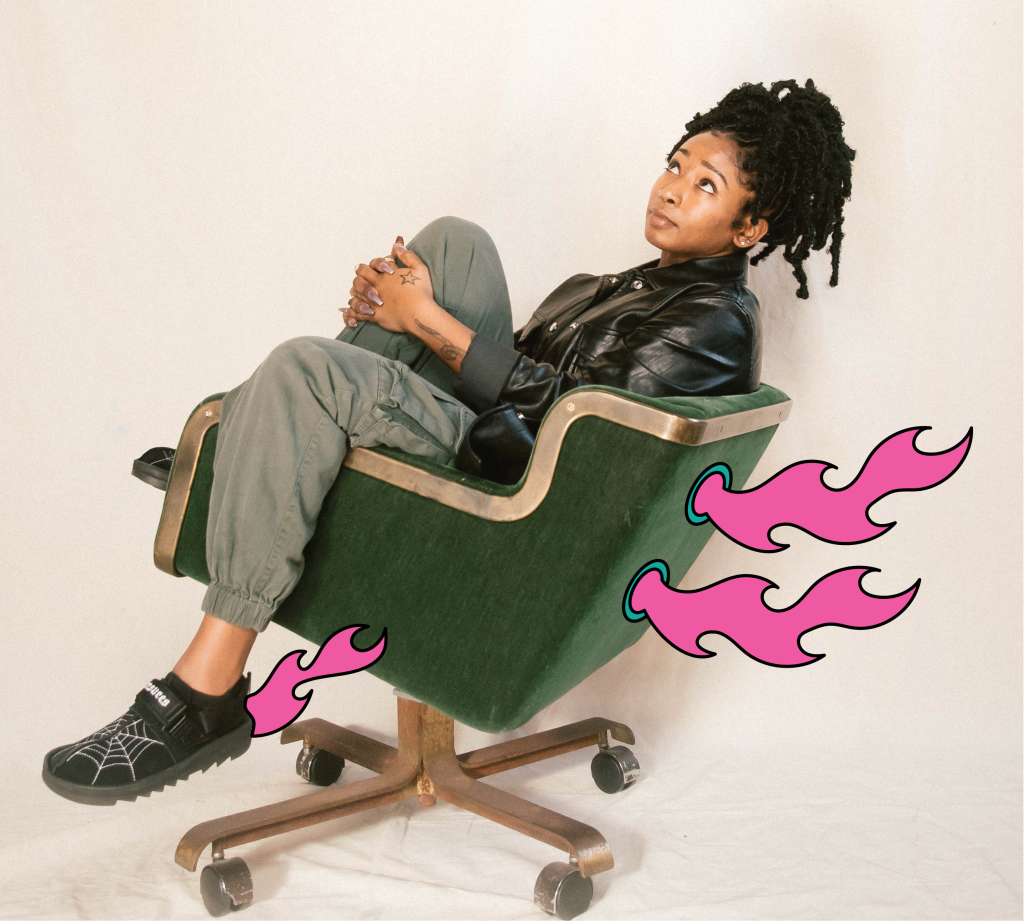
Trap Bob. Photo by Dusty + illustrations by Trap.
While the D.C. pride runs deep for both artists, their view is far from narrow. They know that to give our city a seat at the creative table with bigger metropolises, our artists need to expand their horizons. Solomon notes the importance of bringing people in from the outside who really want to know what’s going on here so they can invest in and advocate for the District, and take what we’re doing creatively back to their cities so local artists can get more recognition.
“I think that was something hurting artists and the creative scene here: forgetting there’s more than local,” Solomon says. “Supporting local is important but the support you can add when you get outside of that is what brings a city to become a major scene. You can work from anywhere, but knowing D.C. is where I’m going to do my best work and need to have as my base is going to influence the work I’m doing outside of it.”
And even though Solomon hasn’t had quite the extensive experience living and working in other cities as Pyrate, she’s never been seduced by the siren’s call to get lost in a sea of creatives trying to “make it” somewhere else.
“I stayed here even with people suggesting, ‘Try L.A., try New York,’ because I wouldn’t be inspired the way I am here. The work wouldn’t be as good. This always feels like home. I always miss D.C. when I leave. The appreciation is growing so much. I really think art will save the world and it’s involved in every single thing. I want people to understand that, so I love being able to take on so many different projects.”
Her earnestness is infectious, and it’s easy to become impassioned listening to her speak about the intrinsic and all-encompassing nature of art as both a practice and an industry. Local entrepreneur and digital marketing consultant Kelcie Glass, a close friend and collaborator of Solomon’s, says the artist has the unique disposition to welcome — and find joy in — all interpretations and opinions of her work.
“She uses her work to encourage political and social conversations,” Glass says. “But [she] allows her art to give a lightness that helps us have difficult conversations without being weighed down by some of the trauma that may come with them. As an artist, she is as bright and vibrant as her pieces. She is authentic [and] has a specific style, but that style is always evolving.”
Glass and Solomon became attached at the hip in 2018 when their mutual friend Dominique Wells, or DJ Domo, launched GIRLAAA. The women-centric creative collective marked the beginning of a devoted friendship based on mutual understanding and admiration.
“As a Black Ethiopian woman who creates work for other Black women, she is helping us continue to see ourselves in a city that is, frankly, erasing us due to extreme gentrification,” Glass says. “Seeing Trap continue to show up in these rooms and show up completely as herself is rewarding for us all.”
Solomon’s “I am who I am in any room that I am in” mindset is the type of attitude that will make room for the next generation of artists in the District, Glass adds.
“She dresses as herself, speaks as herself and will hit a J in the parking lot before heading in if she feels like it. She will show upcoming artists to never shrink themselves for corporate and large-scale recognition. You can do it all. She will show them who you are is a huge part of the art you create.”
This truthfulness as an artist and individual is the cornerstone of what solidified Solomon’s partnership with Pyrate. There has never been a reason to be competitive or individualistic in their mindset. It comes naturally to champion one another, and they appreciate all of the ways in which they complement each other.
“He is a super talented, thoughtful artist who doesn’t compromise his style for commercial success,” says Amir Browder of Pyrate’s integrity. “He really has a warmth and great vibe when you see his work. His art makes you feel good and cheerful.”
Browder owns art gallery Homme, also located at 52 O Street, featuring the works of underground artists both locally and globally. He met Pyrate in spring 2019 when they worked together on a successful solo exhibition and says it’s amazing to see where he started and where he is headed.
“He has really taken his art to another level. His work is meaningful and resonates with local artists and Washingtonians [who] can appreciate his take on street art in D.C. — in addition to really feeling the vibe of and keeping the culture of D.C. in his work. He is making D.C. the hub for amazing artists of all disciplines to get global and national recognition, and to be taken seriously.”
A Language Everyone Can Understand
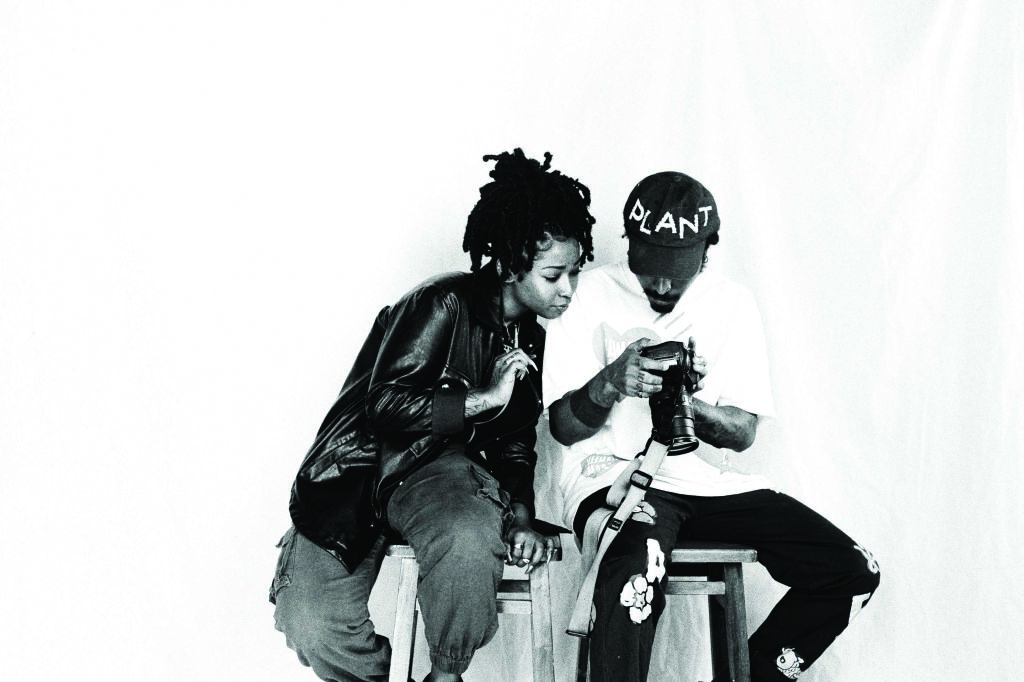
Trap Bob + Chris Pyrate. Photo by Dusty.
Pyrate and Solomon believe in the power behind operating as a united front within creative spaces. They’ve been able to change the landscape of a myriad of projects because they understand each other’s perspective, and in many ways, can help vocalize the needs and priorities of their peers based on years of experience carving new paths, setting boundaries along the way, and ultimately, standing up for themselves and their community.
“We always look at everything not for us, but for who’s going to come after us,” Solomon says. “I feel like we’ve been in spaces you would never imagine an artist to be in. It’s always surprising to us. It’s hard for younger artists or people trying to get their name out there to understand these things. They just want the opportunity — and we don’t want them to get taken advantage of, either.”
Pyrate reflects on his start, remembering what it felt like to be an aspiring artist who saw personal and commercial success as a distant dream and not an impending reality. Many of his peers, and the new wave of up-and-comers, are in that spot now — and he recognizes the struggle.
“I think [for] a lot of artists, getting paid something is the first time you really start to see your trajectory a little differently,” he says. “It helps turn on a different side of your brain as an artist.”
He encourages all artists to mentally check themselves and acknowledge how important they are.
“It doesn’t really matter the level. Everybody has a place. Be diligent. Don’t give up. But also, catch that moment in time when you have to switch gears and become professional — even if it’s a baby step. [Trap and I] aren’t where we are going to end up, but because so many people see this as the spot we’re at, I think it’s important to say, ‘Look, this is how we got here.’”
Art is a business, and they’re committed to sharing the teachable moments of their experiences with budding creatives. Solomon stresses taking control of and manipulating your trajectory to avoid ever feeling abused or exploited.
“Because of our opportunities, we’ve collected an understanding of what we need to do our best work,” she says. “That’s how I think we always put our best foot forward. It’s understanding we’re being appreciated, and not taken advantage of.”
From the outside looking in, their lives might seem like cushy success stories, but Solomon says only a fellow artist can understand what lies beneath the surface. They’re frequently at the point of exhaustion, the hustle is always real and the politics of running your own business — especially as a creative — can be overwhelming.
“We’re growing into spaces [where] there’s even less examples to go by. There’s no roadmap, and there’s even less stops to know where you’re going.”
The trifecta of mental health, financial security and sense of ownership that Solomon and Pyrate strive for builds the confidence needed to make meaningful art at such a critical time in the D.C.’s arts movement. They touch upon last year’s powerful Black Lives Matter protests in the District, and the historical documentation of the murals, posters and other works they joined forces to create with fellow artists. The pivotal messaging behind their art in support of the Black community will forever transcend time and space, living on through the collaborative efforts of so many locals who banded together mid-pandemic to continue to create.
“That’s an artist’s job: to share what the people feel and what we see, and create our depiction of that,” Solomon says. “That’s a beautiful power to have, and it takes both sides to understand that. People appreciate the art here. You can really be a part of it, influence things, have those conversations and continue to build it for the future.”
Pyrate chimes in, describing the creative community as an ecosystem that in many ways thrives because of the continued interest and patronage of art lovers and newcomers alike.
“You get to play a part in a renaissance that’s happening right now.”
The universal nature of art is a love language Pyrate and Solomon speak fluently, and through their ability to rely on one another as sounding boards for everything from a challenging project to a quick venting session, they have resounding intentionality in paving the way not only for their peers but for D.C.’s youth.
“We need to see examples of ourselves too, especially as Black artists,” Solomon says. “We need to see that in person. It surprises me every time I do talks with kids and they’re starry-eyed and can’t believe that exists. They should know they can do anything, especially at that young age. You can go way further than we’ve gone just from having the opportunity [and] those conversations early on.”
From where their collaborators stand, the two artists are already making waves in impactful ways.
“Both artists are not only talented, but they are amazing individuals,” Heard says. “It’d be tough to find two better role models then Trap Bob and Chris. I feel like any city would benefit from calling them both their own.”
Ego really doesn’t seem to enter into the equation for either of them when it comes to their shared desire to see D.C.’s creative scene flourish and develop into something bigger for our city — especially for future artists.
“The idea that somebody who is like me could be out there not feeling like they have that opportunity or like they could do more — it terrifies me,” Solomon says. “I want them to know their potential and see the beauty in the world. Art is a language everybody can understand. It brings people together. It communicates. You can’t have a movement, or anything, without art. It’s just the best thing there is.”
Join Trap Bob and Chris Pyrate at Culture House DC on Saturday, December 11 from 7 p.m. to midnight for a celebration of D.C.’s cultural renaissance featuring 25+ local artists cultivating the scene. “Only in D.C.” is a collaboration between the artists, Events DC and our magazine and will include a panel, artist activations and a vendor market. Learn more at districtfray.com/event/only-in-dc.
Learn more about Trap Bob and Chris Pyrate at trapbob.com and chrispyrate.com and follow them on Instagram at @trapxbob and @chrispyrate.
Culture House DC: 700 Delaware Ave. SW, DC; culturehousedc.org // @culturehousedc
Enjoy this piece? Consider becoming a member for access to our premium digital content. Support local journalism and start your membership today.



